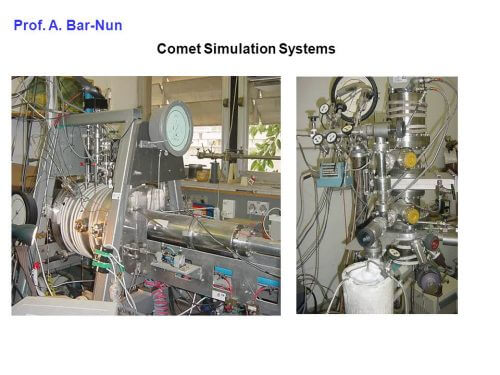Prof. Bar-Nun from the Department of Geophysics from the School of Earth Sciences at Tel Aviv University was the mastermind behind the launch of the Rosetta spacecraft to the nucleus of a comet. He studied every object that is not a star, from asteroids and comet nuclei, through the planets in the solar system to giant planets in other solar systems. He also recreated the surface of comet nuclei in the laboratory

Last night, Prof. Akiva Bar-Nun, a researcher of comets, planets and moons in the solar system and the processes that led to the formation of life on Earth, passed away. He was 77 years old when he died.
Prof. Akiva Bar-Nun from the Department of Geophysics and the School of Earth Sciences at Tel Aviv University has studied every object that is not a star, from asteroids and comet nuclei, through the planets in the solar system to giant planets in other solar systems. He also reproduced the surface of comet nuclei in the laboratory, and participated in Operation Rosetta. He has also been interviewed many times by the science website about the operations in which he participated and also about findings from spacecraft that studied planets outside the solar system or signs of life in space.
Prof. Bar-Nun's four-decade career in "breeding comets" led him to be part of the scientific team of two of the most interesting spacecraft launched in recent decades - both by the way of the European Space Agency: Huygens, which landed on Saturn's moon Titan, and Rosetta, which began orbiting and even sent The Philae lander to the nucleus of Comet 67P in 2014, these were the first missions of their kind.
Prof. Bar-Nun was the CEO of the Israel Space Agency in 1989-1993 and continued two years later as the agency's vice-chairman, the late Prof. Yuval Neman.
Through the use of a unique device developed in Prof. Bar-Nun's laboratory at Tel Aviv University, the researchers were able to simulate a comet's glacier and found that comets contain essential substances that provide the basic nutrients of life. Professor Bar-Non mainly focused on the noble gases argon, krypton and xenon, since they do not react at all with other elements and therefore they are not destroyed by oxygen found on Earth. These elements have maintained their concentration in the atmosphere in a stable manner throughout the lifetime of our planet, explains Prof. Bar-Non in an article from 2009.

Rosetta
With the launch of the Rosetta spacecraft in 2004, We asked Prof. Bar-Nun a question that today seems problematic: will you still be in an active position when he reaches his destination in 2014?
"At the time, several years ago, there was a question in the European Space Agency when to launch the Rosetta spacecraft, because the European Space Agency had four junction points, it had to decide on its priorities. At that famous yeshiva I looked at the heads of all the researchers and most of them already had shiva hair back then. I suggested to them that if they put it off too much, when we get to Shavit we won't even remember what we came there for and we certainly won't look at the results. And really with the same result it was decided that we would be earlier compared to other spacecraft of the European Space Agency. I really hope that there will be no problems with this launch, and then the spacecraft will actually travel on its way for many years until it reaches the comet."
Indeed, in November 2014, in preparation for my trip to Darmstadt, to watch the historic launch of the Philae lander on comet 67P, he was interviewed again, this time as a member of the Rosina group, one of the instruments on board Rosetta and told about its discoveries, and in particular the presence of molecular nitrogen. A few weeks ago we reported on the smashing of Rosetta to the ground of the comet and the end of the operation. At this stage, Prof. Bar-Nun was already very ill, but at least he managed to close a circle and participated in the planning and analysis of the findings from two of the more interesting missions in the solar system.
One of the last discoveries in which Prof. Bar-Nun participated was the discovery of liquid nitrogen in the nucleus of the comet.
planets outside the solar system
One of the first interviews given by Prof. Bar-Non and published on the Hidan website was in 1998, when scientists published the results of a study they conducted on the Pegasi 51 system - the first outer solar system ever discovered.
"Until the discovery of these planets, we thought we understood how the solar system was formed. In our solar system, all the minor planets are close to the sun, and they contain mostly rock and iron. When we move out to the edge of the solar system, we find gas giants, especially Jupiter and Saturn, which have a mass a thousand times greater than the mass of the Earth, and this is because they collected all the gases that were around when the Solar System was formed, while the Earth, for example, collected only rocks and minerals".
In October 1999, in preparation for the launch of the FAME satellite - the first satellite built specifically to search for planets outside the solar system. It was only about four years earlier that planets orbiting other suns had even been discovered. On this occasion I asked Prof. Bar-Nun: If there are so many planets, why can't we find life?
Cassini-Huygens
Prof. Bar-Nun, was a member of the scientific team of the Cassini-Huygens spacecraft of NASA and the European Space Agency. This spacecraft still orbits the planet Saturn and has remotely inspected its moon - Titan - the only moon with an atmosphere in the solar system. Shortly after entering orbit around Saturn in January 2005, the Huygens lander was launched from it and landed on Titan. Prof. Bar-Nun was at the European Space Agency's headquarters in Darmstadt at the time, and from there I spoke on the phone in real time: "The research group of Prof. Bar-Non has been studying Titan's atmosphere for 30 years. She predicted the discovery of propane gas, which was indeed found in the atmosphere by NASA's Voyager spacecraft. Now she predicts the chemical composition of the haze that will be tested when Huygens passes through the atmosphere." We wrote then, and indeed in a telephone interview from the control center of the European Space Agency in Darmstadt
How do you sum up the sale that culminated on Friday?An exception, this is a success for Huygens.
How long have you been working on the project?I have been participating in this project for 15 years and working on Titan for 30 years.
Have you received confirmation of your prophecies?"All my predictions were successful. The first prediction was that there would be no noble gases - argon krypton and xenon in Titan's atmosphere or trace amounts of them, because they are trapped in the haze from aerosols that forms in the atmosphere and descends over time. This haze over time cleans the atmosphere of these noble gases. Another prediction was that there would be no lightning in Titan's atmosphere, they made a special microphone on Huygens that would detect the noise of thunder and he found nothing. There really is no lightning on Titan, contrary to other people's opinions. The microphone was open for the two hours the spacecraft made its way down, which is enough time that if there were any thunder we would hear it.
Another point is that we were afraid about 10 years ago that this haze would be sticky. According to our experiments in the laboratory. We were afraid that he would block all the openings of all the devices and interfere with the detectors. Over the years since then we have come to the conclusion that the small grains of haze will harden or harden or harden and therefore they will be like marbles of glass and not like sticky grains. Indeed, the haze grains did not stick to Huygens' detectors."
intelligent life in the universe
In a 1999 interview Prof. Bar-Non responded to the question of the editor of the science website about the possibility of intelligent life in space, Prof. Bar-Non said: "If you look at the creation and evolution of life on Earth, it seems that it was created 3.6 million years ago, while only 200 million years before Earth was still bombarded with asteroids. During most of the period of life on Earth, they were at the level of micro-organisms - cyanobacteria. Very primitive creatures. Only 700 million years ago, slightly more complicated creatures began to emerge, only in the last 10,000 years can we talk about civilization, and only in the last 100 years has a technological civilization been created. Life is easily created, but life with a technological civilization is a very small fraction of the time that life exists. It is possible that in other places the stars become red giants and swallow the life-bearing planets before they had time to develop."
